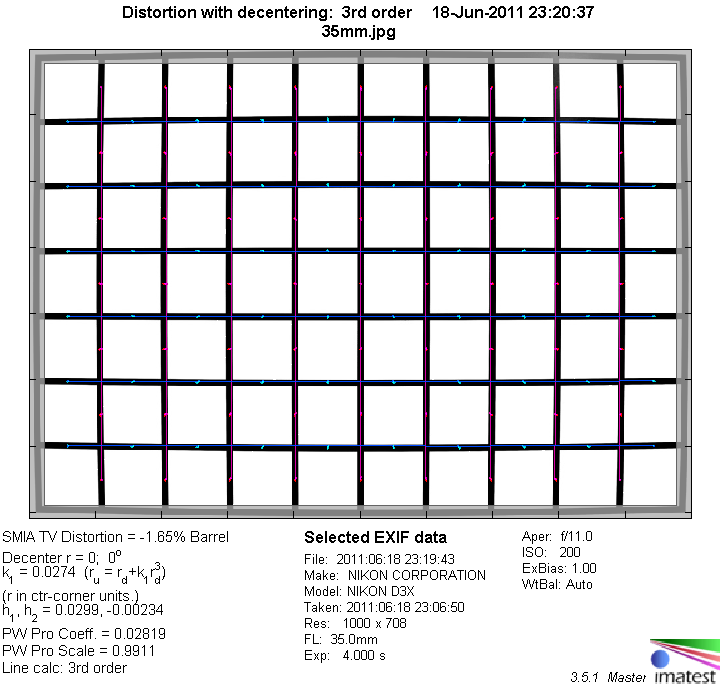|
Samyang 35mm f/1.4 AS UMC (Nikon FX) - Review / Test Report - Analysis |
|
Lens Reviews -
Nikon / Nikkor (full format)
|
|
Page 2 of 3

Distortion
The Samyang 35mm f/1.4 shows a moderate amount of barrel distortion (~1.6%) which is usually not overly disturbing in field conditions.

The chart above has a real-world size of about 120x80cm.
Vignetting
In its native full format scope it produces a very heavy amount of light falloff at large aperture settings. The vignetting exceed 1.7EV (f-stops) at f/1.4 and it's still very pronounced at f/2 (1.1EV). The issue is quite well controlled at f/2.8 and not relevant anymore from f/4 onwards. This may sound like a drawback but this is actually marginally better than on the Nikkor AF-S 35mm f/1.4G.
We're performing our vignetting analysis based on
(uncorrected) JPEGs straight from the camera. The JPG engine of the Nikon D3x features a rather flat
gradation curve, thus has a moderate contrast characteristic, resulting in comparatively low vignetting figures - the
corresponding Canon figures are roughly 40% higher due to the more
aggressive default contrast setting.

MTF (resolution)
The Samyang 35mm f/1.4 AS UMC was capable of delivering very high quality results in the MTF lab. The center is very good at f/1.4 and both the borders and corners aren't much worse either. The contrast level is slightly reduced at this setting though. There's only a slight gain in quality at f/2 but the resolution characteristic is really impressive from f/2.8 onwards. The center is pretty much outstanding between f/4 and f/8 and the outer image zone is also very good to excellent. Diffraction effects have a slight impact at f/11 but the quality is still very good here. There's only a slight amount of field curvature. The tested sample showed a slight centering defect.
Please note that the MTF results are not directly comparable across the different systems!
Below is a simplified summary of the formal findings. The chart shows line widths
per picture height (LW/PH) which can be taken as a measure for sharpness.
If you want to know more about the MTF50 figures you may check out the corresponding
Imatest Explanations

Chromatic Aberrations (CAs)
Lateral CAs (color shadows) are quite low with an average pixel width of around ~0.8px at the image borders.

Bokeh
The quality of the bokeh (rendering of the out-of-focus blur) is, of course, a major aspect for an ultra-large aperture lens. The Samyang lens does not convince completely here. Out-of-focus highlights have a slightly nervous inner zone. The highlight shape remains pretty circular till about f/2.8 though - that's excluding the border/corner zone where the highlights suffer from the usual "cat's eyes" effect due to vignetting. The background blur is rather busy whereas the foreground blur is reasonably smooth.

Bokeh Fringing / Longitudinal Chromatic Aberrations (LoCA)
Bokeh fringing is a common problem among large aperture lenses. At f/1.4 and f/2 you may be able to spot purple halos in front and green halos beyond the focus point. The issue is reduced at f/2.8 and not really visible anymore from f/4.
You may notice that the focus shift (so-called "residual spherical aberrations) is quite minimal.
|
Move the mouse cursor over the f-stop marks below to observe the respective LoCAs
|
| f/1.4 |
f/2 |
f/2.8 |
f/4 |
f/5.6 |
|

|
|